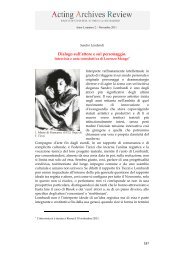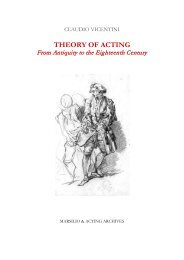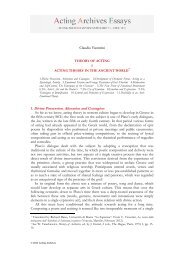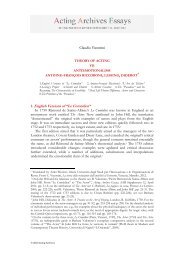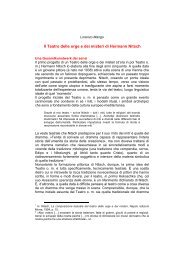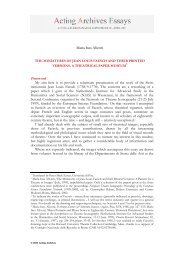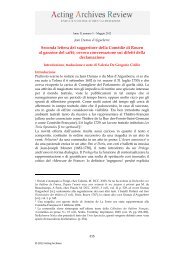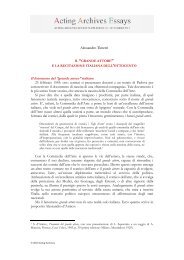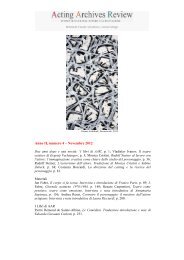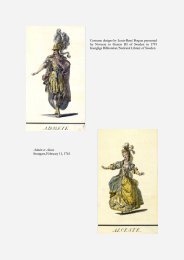Flavia Pappacena_Noverre's Lettres sur la Danse - Acting Archives
Flavia Pappacena_Noverre's Lettres sur la Danse - Acting Archives
Flavia Pappacena_Noverre's Lettres sur la Danse - Acting Archives
Create successful ePaper yourself
Turn your PDF publications into a flip-book with our unique Google optimized e-Paper software.
AAR <strong>Acting</strong> <strong>Archives</strong> Essays Supplement 9 – April 2011<br />
Giselle (act I) 54 and the mingling of James and the house guests in Bournonville’s La<br />
Sylphide (act I). 55<br />
To return to the question of the possibilities of gesture, the sources suggest how<br />
in Noverre’s dance form not all the emotions and states of mind were assigned to the<br />
<strong>la</strong>nguage of gesture. When it came to rendering dramatically delicate moments or<br />
passages full of nuance, Noverre made use of elements drawn both from iconology<br />
and from spatial composition pertaining to painting and indeed to academic ballets.<br />
In this respect two scenes from Énée et Didon are exemp<strong>la</strong>ry. In the first (early on in<br />
the ballet), Amor in the guise of Ascanius passes from the embrace of one into the<br />
arms of the other, illustrating the mutual love of the two protagonists. The second<br />
(part III, scene III) occurs when the love of Dido and Aeneas is consummated in the<br />
sanctuary of a grotto. Only Cupid is able to steal the occasional glimpse, and he<br />
coordinates Juno, Venus and Hymen in a pas de quatre which evokes the amorous<br />
encounter for the audience. Another instance illustrating this compositional method<br />
with great c<strong>la</strong>rity comes in Médée et Jason, with the macabre, grotesque dance of the<br />
personifications of the sentiments (Hatred, Jealousy, Revenge) which derange Medea<br />
and drive her to carry out her vendetta. And we could add the dotted lines and acute<br />
angles, adopted from c<strong>la</strong>ssical iconology, which were b<strong>la</strong>zoned on the costume of<br />
Medea as a visual evocation of the sorceress’s evil nature. There could be no more<br />
conclusive example than the episode in Le Jugement de Pâris, cited in Letter XX (1803),<br />
in which Paris awards Venus the golden apple. To make Venus’s offer to Paris<br />
explicit, and above all ‘concrete’, Noverre has the bust of Helen of Troy led on to<br />
the stage by the Graces and Cherubs, the conventional symbols of love.<br />
In condemning acute angles and dotted lines (whether in gesture or in port de bras),<br />
while at the same time interpreting the curve as a sign of positive values and good<br />
breeding, Noverre was not merely adopting a convention of academic dance, but<br />
respecting an aesthetic principle of c<strong>la</strong>ssical art which imbued eighteenth century<br />
culture. In theoretical works published around the middle of the century, authors<br />
ranging from Voltaire to Edmund Burke and William Hogarth, as well as Antoine-<br />
François Riccoboni, concurred that soft, round contours constituted a tangible<br />
manifestation of finesse. In c<strong>la</strong>ssical culture continuity was seen as an expression of<br />
equilibrium and decorum, while the sinuous line, a distinctive trait of the aesthetics<br />
of the age of Louis XV, tended to be associated with physical plea<strong>sur</strong>e.<br />
In conclusion, the symbolism of the passions or “situations” was to be conserved,<br />
albeit in a different form, in Romantic ballet. As evidence we can cite the various<br />
meanings of the circle (for example in Giselle, as fate or the death ritual) or the<br />
diagonal en remontant (again in Giselle, when executed by the Willis it is a sign of<br />
exclusion), or indeed the celestial melodies (the arrival of the Immortals), miraculous<br />
rays of light, and so on.<br />
54 The ballet Giselle, choreographed by Jean Coralli and Jules Perrot on a subject by Théophile Gautier,<br />
libretto by Jules-Henri Vernoy de Saint-Georges and music by Adolphe-Charles Adam, was first<br />
performed at the Paris Opéra on 28 June 1841.<br />
55 The version of La Sylphide created by the Danish choreographer August Bournonville to music by<br />
Hermann Severin von Lovenskjøld was first performed in Copenhagen at the Royal Theatre in 1836.<br />
16



